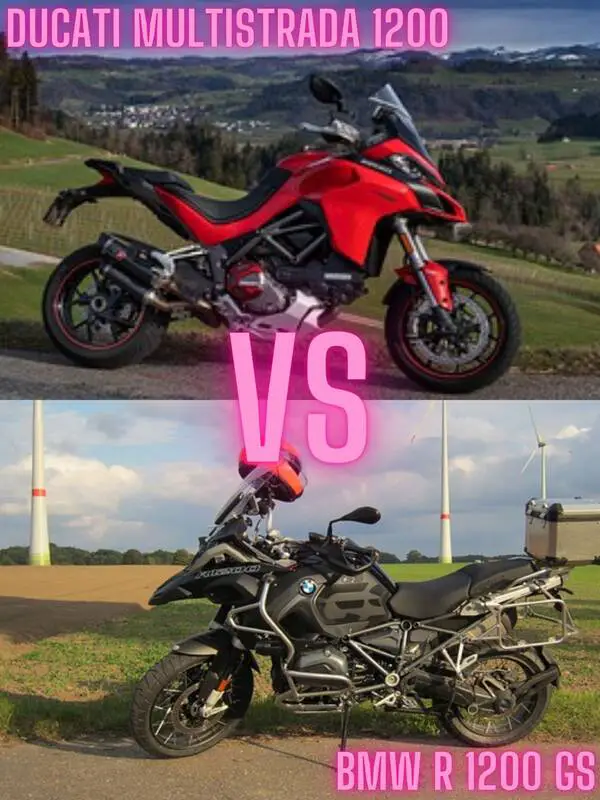Adventure bikes help you realize your dream of traveling. But the right kind of bike is an adventure itself. So, when we were presented with two very different options, we just had to compare them.
The Ducati Multistrada 1200 is a gasoline-powered adventure-touring bike with a top speed of 145 mph. And the BMW R1200 GS is a similar bike with a top speed of 130.8 mph. Both bikes have quite a lot of similarities, but they’re more different than you think.
And we’re here to sort them out. Take a look at our complete Ducati Multistrada 1200 vs. BMW R 1200 GS comparison and see the difference yourself.
Industry History:
Ducati:
Ducati Motor Holding S.p.A is an Italian motorcycle company that Lamborghini owns. It was initiated in 1929 by Antonio Ducati and his three sons. Its first motorcycle was Cucciolo-based. And today, it employs some of the most advanced automotive technologies to ensure reliability.
BMW:
BMW, short for Bayerische Motoren Werke, was founded in 1917 under a different name. The company came into its present state after the Second World War. Since then, it has pioneered countless bicycles, motorbikes, cars, and even pots and pans. The brand owns Rolls Royce and BMW Motorrad.
Ducati Multistrada 1200 Vs. BMW R 1200 GS – An Overview:
Ducati Multistrada 1200:
The Ducati Multistrada is a product line that’s nearly two decades old, and the 1200 version lives up to its legacy. This is a line of adventure-tour bikes that are also available in racing and sporting variants. With a revamped V-4 engine that offers a mileage of up to 60,000 km, the Ducati is a beast on the road. It’s the perfect choice for anyone who likes to take their adventures to the max.
BMW R 1200 Gs:
The BMW R1200 GS is a slightly tweaked successor of their R1200 motorbike. It’s an adventure-touring bike meant for casual use both on and off-road. This is the first BMW R1200 bike to use water-cooling in its system, which results in unmatched efficacy. And the solid sporty design leaves other tourers stunned. And this is one of the very few bikes that features Dynamic ESA, making adjusting the suspension a piece of cake.
Comparison Chart:
| Feature | Ducati Multistrada 1200 | BMW R 1200 GS |
| Fuel and Vehicle Type | Gasoline Adventure-Tourer | Gasoline Adventure-Tourer |
| Fuel Tank Capacity | 20 liters | 20 liters |
| Displacement | 1198.4 cc | 1170 cc |
| Max Power | 157.8 bhp | 124 bhp |
| Max Torque | 136 Nm | 125 Nm |
| RPM @ Max Power | 9,500 rpm | 7,750 rpm |
| Seating Capacity | 2 | 2 |
| Weight | 235 kg | 274 kg |
| Gear Transmission | 6-speed | 6-speed |
| Front & Rear Suspension | 48mm fully adjustable USD – Fully Adjustable Unit | BMW Motorrad Telelever – Cast aluminum swingarm (single-ended) |
| Front & Rear Wheel Size | Rear: 17” Front: 17” | Rear: 17” Front: 19” |
| Seat Type | Two-stepped | Two-stepped |
Engine:
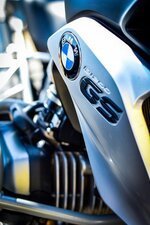
Our Ducati Multistrada 1200 vs. BMW R 1200 GS comparison cannot begin without the engine. It’s the heart of your bike’s performance and efficiency. The Ducati Multistrada 1200 uses a 4-stroke DOHC engine, a configuration well-known for its high performance. It allows for better ventilation for reaching higher top speeds than its predecessors.
This bike has a displacement of 1198.4 cc, enabling it to reach a maximum torque of 136 Nm at 7,500 rpm. Moreover, it can reach a maximum power of about 157.8 bhp at 9,500 rpm. So, you know it’s a powerful engine.
But what about the durability? Ducati’s 4-stroke engine optimizes spring distribution. This results in a longer interval for checking the valve clearance. To be more precise, you should check the valve clearance every 60,000 km.
Compared to that, the BMW R 1200 GS uses an engine with 1,170 cc of displacement and a maximum torque of 125 Nm at 6,500 rpm. The difference is only slight, but when you’re trying to save as much fuel as you can, everything matters.
Moreover, the engine on the BMW is partially water-cooled and partially air-cooled. This results in more effective cooling. This new engine also features a redesigned crank that helps mitigate drag and a new counterweight that keeps vibrations at a minimum.
Overall, both the engines are certainly quite powerful, and both are equally as intricately designed. But the Ducati has a slightly better engine that will last longer. The BMW does have an engine that has more convenient features, such as reduced vibration and better cooling. But since motorbikes are not cheap, which means durability wins over convenience.
Weight:
You’ve probably heard a lot of people talking about weight when comparing bikes, and they’re not wrong to do so. Weight decides everything from fuel economy to accident safety and even braking convenience.
The Ducati Multistrada 1200 has a curb weight of 235 kg, whereas the BMW R 1200 GS has 274 kg. The BMW is heavier, so it’s going to be lesser efficient.
To be more precise, since it’s heavier, it will require a more powerful engine, which we’ve already established it lacks. This will significantly reduce fuel economy. The difference is a whopping 40 kg, something you cannot dismiss.
So, in all regards, the Ducati wins this round. It’s lighter, has a better gas mileage, is safer, and is easier to break.
Suspension:
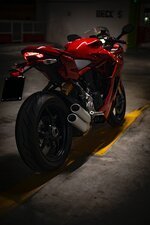
Suspension is a major buying factor that many newbies overlook. We paid extra attention to the suspension in our Ducati Multistrada 1200 vs. BMW R 1200 GS review.
Ducati features a 48mm fully adjustable USD fork front suspension along with a fully adjustable rear suspension. USD forks are better suited for high-speed applications, where they need to sustain a lot of weight and force. They last longer than their upright counterparts.
Additionally, since the forks are fully adjustable, you can tweak the damping to your taste. This is a great feature for any bike, though adjusting the suspension won’t be easy.
The new BMW R1200 GS uses its proprietary BMW Motorrad Telelever. One reason why the Telelever suspension works so well is that it’s for practical applications. Most other suspension forks work efficiently on smooth roads, but the Telelever adapts to every situation.
For the rear suspension, the BMW uses a cast aluminum single-sided swingarm. Additionally, you can opt for semi-active suspension as an extra feature. What’s more, this bike features a Dynamic ESA, which automatically adjusts the bike’s damping for you. You can toggle between different ESA settings via the pre-set five riding modes.
Since the BMW has the Telelever suspension and the Dynamic ESA, it’s much better than the Ducati in this regard. So, it’s safe to say that the BMW wins this round.
Ergonomics:

In terms of comfort and ease of use, both the Ducati and the BMW have a lot to offer. The Ducati is shaped like your average sports bike, though it’s not meant for racing. As such, your posture on the bike will be slightly leaning forward. This helps balance your center of gravity and keep the journey comfortable. The Ducati also featured a two-tiered pillion seat that gives your pillion a better view of the road.
As for the BMW R 1200 GS, it follows a similar design. It looks and feels sporty but is meant for adventure and touring. Your posture stays the same, leaning forward with your feet slightly behind you. The handlebars are easy to grip and do not slip in your hands.
However, there is one major factor that ultimately tips the scales: weight. Since then, Ducati has been fitted with lighter wheels and a more ergonomic chassis. It’s easier to handle and accelerate. Plus, the braking distance is relatively short, leading to more abrupt and safer brakes.
Overall, both the bikes offer a lot in terms of ergonomics. But since the Ducati is significantly lighter and easier to control, it wins this round.
Electronics:
In our comparison of the Ducati Multistrada 1200 vs. BMW R 1200 GS, we felt it was necessary to include the electronics.
The Ducati employs quite a lot of electronic components, such as the Brembo brakes. These brakes lead to an abrupt stop, which will save you in the event of a crash. But that’s not all.
The Ducati Multistrada also features ABS (Anti-Lock Braking System) control. It’s quite a common technology that ensures the safe operation of your brakes and smooth cornering.
One special feature that you get on the Ducati is the Bosch Inertial Measurement Unit. It ensures abrupt braking even at steep angles. Then there’s the traction control that brings the best out of your drive.
Moving on to the BMW R1200 GS, it has its collection of fancy technologies. The first is the ABS control, which ensures smoother turning at every corner. After that, you have the ASC control, a basic form of traction control, great for maintaining your tempo.
Moreover, this bike features its signature Dynamic ESA technology. This automatically adjusts suspension damping. You also get tire pressure sensors, an alarm, LED lights, and even heated grips.
Since the BMW has some extra unique features and Dynamic ESA, it beats the Ducati when it comes to electronics.
Aesthetics and Looks:
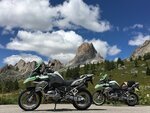
Of course, when we’re comparing the Ducati Multistrada 1200 vs. BMW R 1200 GS, how can we forget the aesthetics? After all, half of the reason for picking a bike is that it looks cool.
Regarding that, both the bikes feature some mind-blowing designs. And it’s really up to you to decide which bike looks better.
The Ducati Multistrada follows Italian design principles. The design is strikingly similar to other sports bikes, despite it being a touring adventure bike. The chassis is sure an eye-catcher. Your bike will look different from all other adventure bikes on the trail.
A similar design is featured on the BMW R1200 GS, though it’s not as sharp-ended or aerodynamic. The “beak” on the bike is a lot shorter, and the rear fender is not as long or curved. This gives the impression of a heavier, more casual bike, fit for adventuring and touring.
Now, this is a decision only you can make. But we like the Ducati’s aesthetic. It looks sportier and is undoubtedly no bystander when it comes to design.
Pricing:
Finally, what you’ve all been waiting for: the price. Comparing the prices between the two bikes, it’s evident that the BMW R1200 GS costs less. But this doesn’t necessarily mean it’s a better bike
For one thing, the BMW has a weaker engine, though it can reach incredible top speeds on its own. The only feature that stands out is the Dynamic ESA and the multiple riding modes missing from the Ducati.
The Ducati has some amazing features, too, such as the more powerful engine but lighter chassis. This is what raises its price higher.
All in all, both the bikes satisfy the price point. But since the BMW is cheaper, it’s the clear winner here.
Ducati Multistrada 1200 Vs. BMW R 1200 GS – The Similarities:
Fuel and Vehicle Type:
One thing similar in both the Ducati Multistrada 1200 vs. BMW R 1200 GS is the fuel and vehicle type. Both of these bikes run on the same type of fuel (petrol). And they’re designed to be adventure-tour bikes. However, some racing versions are available as well for both bikes. They both provide high top-speeds that easily compete with those of sport and dual-sport bikes.
Engine and Performance:
While the engines used in the bikes are different, their performances are quite similar. Both engines can achieve high maximum torques with high RPMs. They also feature liquid-cooled systems, though the BMW is partially air-cooled. What’s more, each of these is a 4-stroke engine with a similar displacement, though the Ducati has a slighter wider displacement.
Ignition and Gearing System:
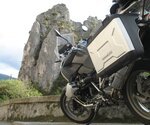
Now here’s the most significant similarity between the two: the transmission. Both the bikes feature a 6-speed transmission, with one having a chain drive and the other a shaft drive. They’re both easy to shift gears with and don’t present a lot of resistance. However, it should be noted that the clutch on the Ducati is wet, while that on the BMW is a dry clutch.
Another similarity is the ignition type. Both bikes feature a twin spark ignition, which provides a backup ignition if the first one fails.
Additional Features:
Since both the machines feature ABS cornering, they’re equally as smooth to turn and steer. Additionally, they both feature an ergonomic design that maximizes user comfort. And since they’re adventure-tour bikes, they pack a lot of potentials on the road as well as off of it. Moreover, both bikes have the same fuel capacity (20 liters), though the Ducati has a better fuel mileage due to its low weight.
Ducati Multistrada 1200 Vs. BMW R 1200 GS – Pros & Cons:
Ducati Multistrada 1200:
Pros:
- More powerful engine
- Lighter in weight
- Includes ABS and Brembo brakes
- Sporty design
- Easier to handle and control
Cons:
- Mediocre suspension
- Costlier
BMW R 1200 Gs:
Pros:
- Better suspension system
- Dynamic ESA technology
- Features ABS control
- More efficient engine cooling
- Lesser vibrations
Cons:
- Weaker engine
- Heavier in weight
Conclusion:
Considering the Ducati Multistrada 1200 vs. BMW R 1200 GS comparison factors and the similarities, it’s safe to say that the Ducati is better than the BMW. It is lighter, which means it’s easier to control. And it has a more powerful engine that lends it a higher top speed and torque.
Lastly, the final decision is in your hands. There’s no point in reading the comparison if you won’t act upon it. Choose the right bike for yourself and enjoy carefree cruising.

